Last Updated on March 3, 2025 by Owen McGab Enaohwo
![20+ Free SWOT Analysis Templates [Downloadable + Easy to Use]](https://www.sweetprocess.com/wp-content/uploads/2025/02/swot-analysis-template.png)
What’s holding your business back from reaching its full potential? What strengths can you leverage to overcome challenges?
These are critical questions every small business owner or manager should ask.
Many small businesses struggle to identify the root causes of their problems or miss out on opportunities due to a lack of structured analysis. Without a proper approach, decision-making can feel overwhelming, and you might miss opportunities for improvement.
This is where a SWOT analysis comes in — a simple yet powerful tool for mapping your internal strengths and weaknesses while identifying external opportunities and threats. It’s the starting point for business owners looking to build strategies that work and solve problems.
By evaluating these internal and external factors, you can discover valuable insights that drive organizational growth.
In this guide, we’ll walk you through the concept of SWOT analysis and how your business can benefit from it. We’ve also compiled 20+ free, easy-to-use SWOT analysis templates to help you get started quickly and efficiently.
Ready to take your SWOT analysis to the next level? Sign up for a free trial of SweetProcess today and discover how easy it is to create, manage, and document your SWOT analysis seamlessly.
Table of Contents
22 Free Editable and Downloadable SWOT Analysis Templates
How to Enhance Your Company’s SWOT Analysis Using SweetProcess
Benefits of Conducting SWOT Analysis for Your Business
Best Practices for Using SWOT Analysis in Your Business
Streamline Your SWOT Analysis Process Using SweetProcess
What Is a SWOT Analysis?

A SWOT analysis is used as a strategic planning tool to identify internal and external factors that impact your business and guide decision-making.
SWOT is short for strengths, weaknesses, opportunities, and threats. Organizations use this four-step framework to evaluate their operations.
With this SWOT framework, you can evaluate your company’s competitive position and identify internal and external elements that can impact the current and future business activity. When done correctly, a SWOT analysis provides key data to help you know what’s holding you back and how to leverage opportunities.
Here’s what each component of SWOT entails:
- Strengths: What does your organization excel at? These are internal advantages or resources that set you apart from competitors. For instance, you might have a skilled workforce specializing in cutting-edge technology, a strong brand reputation, or proprietary technology that allows you to innovate faster than your competitors and attract high-value clients.
- Weaknesses: What areas need improvement? Weaknesses are internal factors that hinder your growth or performance. For instance, your organization might have outdated processes, lack of resources, or poor customer service, which makes it harder to compete and meet customer expectations.
- Opportunities: Consider all the external trends, technological advancements, and market changes your business can take advantage of. For instance, if you are already experimenting with eco-friendly packaging materials, there’s a growth opportunity as more people demand sustainable practices. You can capitalize on these factors to grow your business.
- Threats: Your business will encounter external risks that could impact its success. These include competition, economic downturns, or regulatory challenges. For instance, a new competitor entering the market with a similar product at a lower price point could threaten your market share. The SWOT analysis can help you identify and establish a plan to counter these risks.
21 Free Editable and Downloadable SWOT Analysis Templates

Finding the perfect SWOT analysis template shouldn’t be challenging. With the right template, you can design it for different business scenarios, whether you’re strategizing for a new product, identifying opportunities in a competitive market, or analyzing your team’s performance.
With easy customization options, you can tailor them to your unique needs and start creating actionable strategies right away.
Here are 21 editable and downloadable free SWOT analysis templates to save you time and effort.
1) Google Docs SWOT Analysis Template

The Google Docs SWOT analysis template is a clean, editable, and straightforward chart for analyzing your organization’s strengths, weaknesses, opportunities, and threats. It offers an intuitive format for quick collaboration and easy sharing. This SWOT matrix template is ideal for small business owners, managers, or team leaders who want a simple tool to guide strategic planning.
Download the Google Docs SWOT Analysis Template
2) Google Sheets SWOT Analysis Template

This free SWOT analysis template is an easy-to-use spreadsheet for collaborative SWOT analysis. Its clear grid format makes it easy to input and categorize strengths, weaknesses, opportunities, and threats, allowing for easy data entry and visualization. This template is perfect for teams working on shared insights in real-time.
Download the Google Sheets SWOT Analysis Template
3) PowerPoint SWOT Analysis Template

The PowerPoint SWOT analysis template comes in handy when creating a visually engaging and customizable slide deck to present your SWOT analysis diagram in a professional format. This SWOT template is perfect for business presentations, team meetings, or client pitches, allowing you to showcase key insights with clarity and impact.
Download the PowerPoint SWOT Analysis Template
4) Excel SWOT Analysis Template
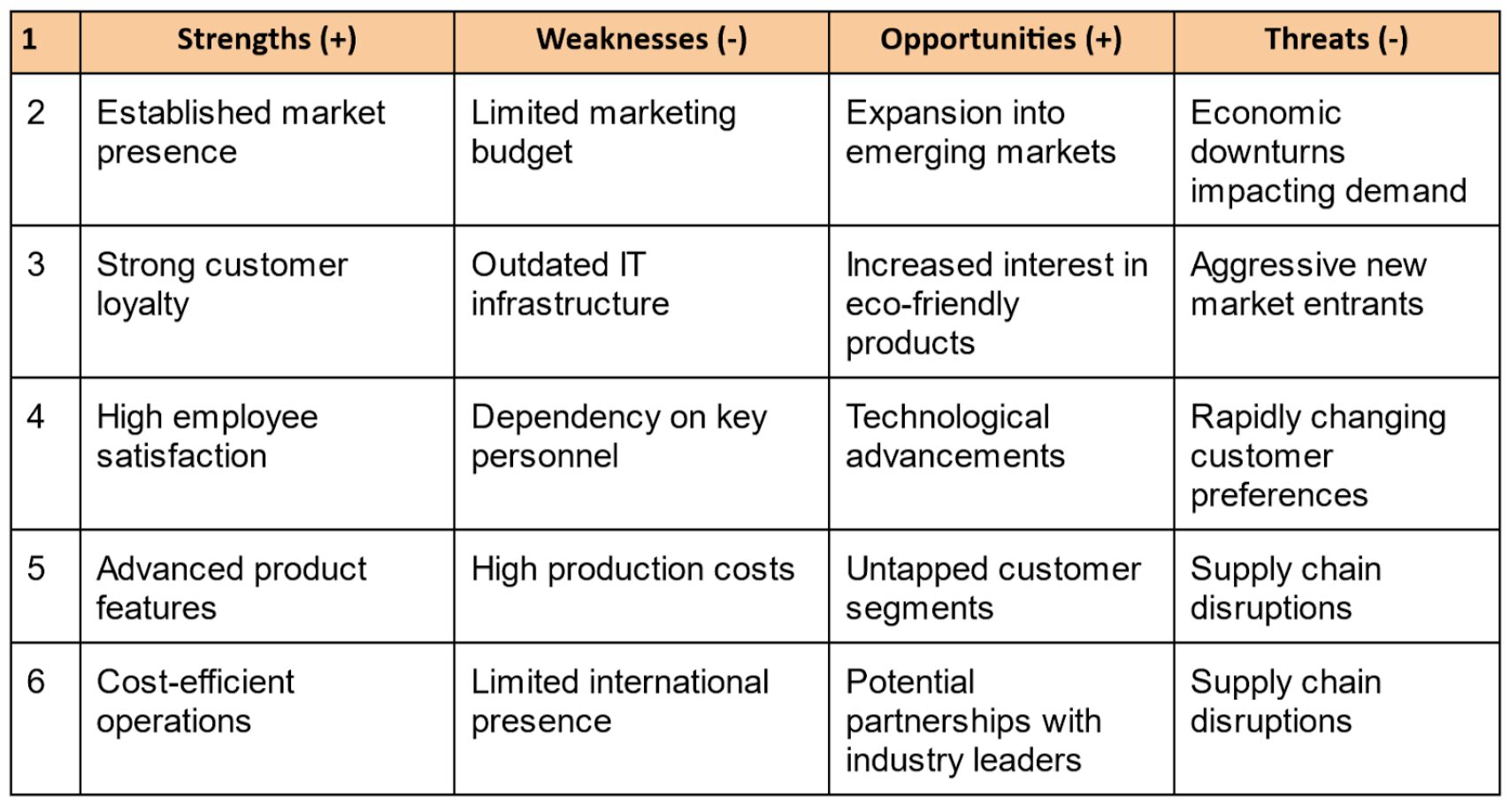
Your business can use the Excel SWOT analysis template to evaluate your performance in a clear grid-based format. The columns and rows make it easier to organize and visualize insights. You can separate sections for strengths, weaknesses, opportunities, and threats in a table format and update them to suit your specific needs.
Download the Excel SWOT Analysis Template
5) Blank SWOT Analysis Template
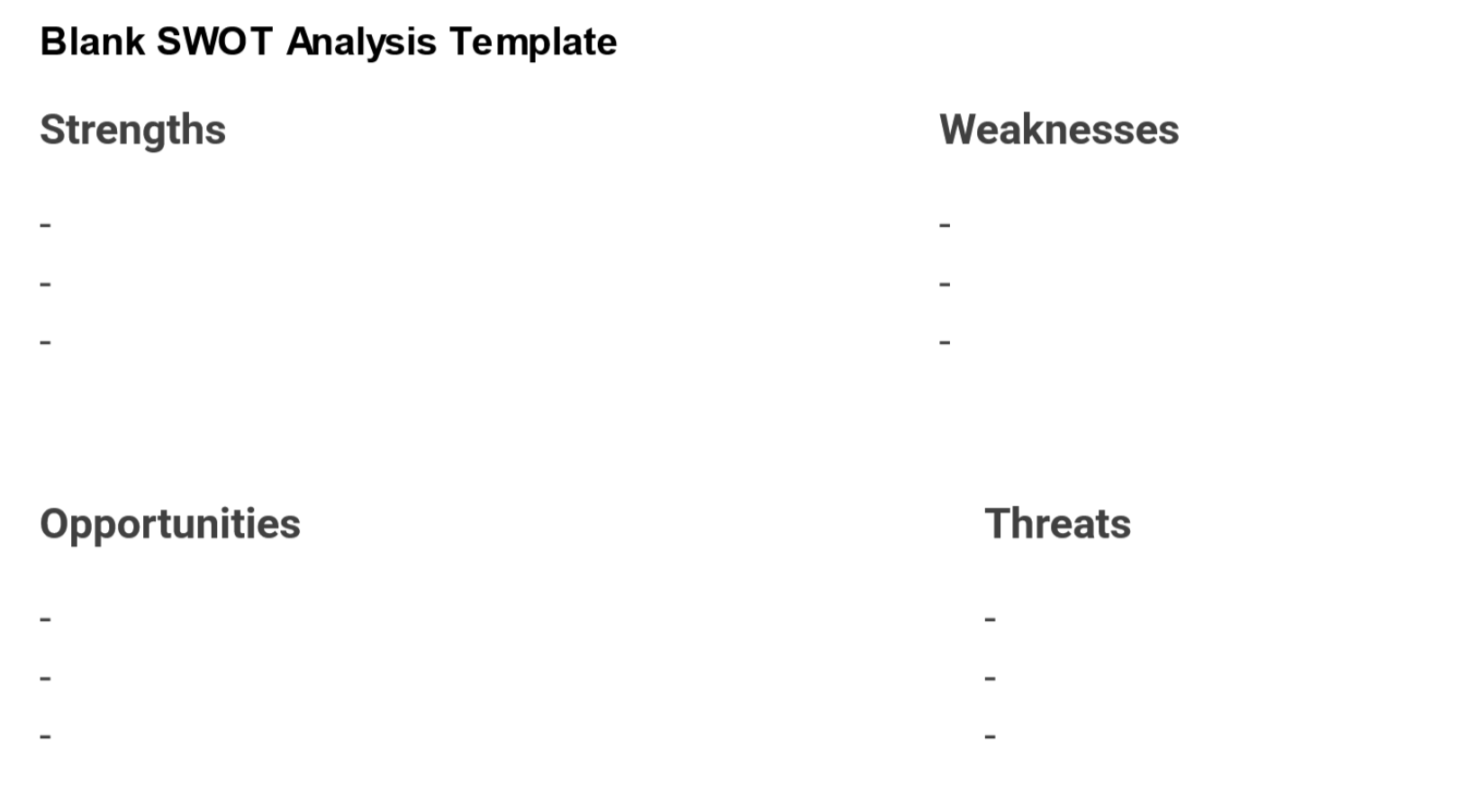
Since every business has unique needs, you can use a blank SWOT analysis template and customize it. Once you download the template, you can fill in every section with insights tailored to your goals. Its simplicity allows for flexibility, making it ideal for team workshops, brainstorming sessions, or personal strategy planning.
You can save time by having this template available at all times.
Download the Blank SWOT Analysis Template
6) Personal SWOT Analysis Template

The personal SWOT analysis template is a self-assessment tool designed for individuals who want to assess their strengths, weaknesses, opportunities, and threats on a personal or professional level. It can be used to identify areas of growth in the business or when planning career development for employees.
It also comes in handy when exploring future opportunities and clarity in your goals. As a business owner or founder, you can use this template to determine if you have the skills to take on more tasks or roles.
Download the Personal SWOT Analysis Template
7) Competitor SWOT Analysis Template
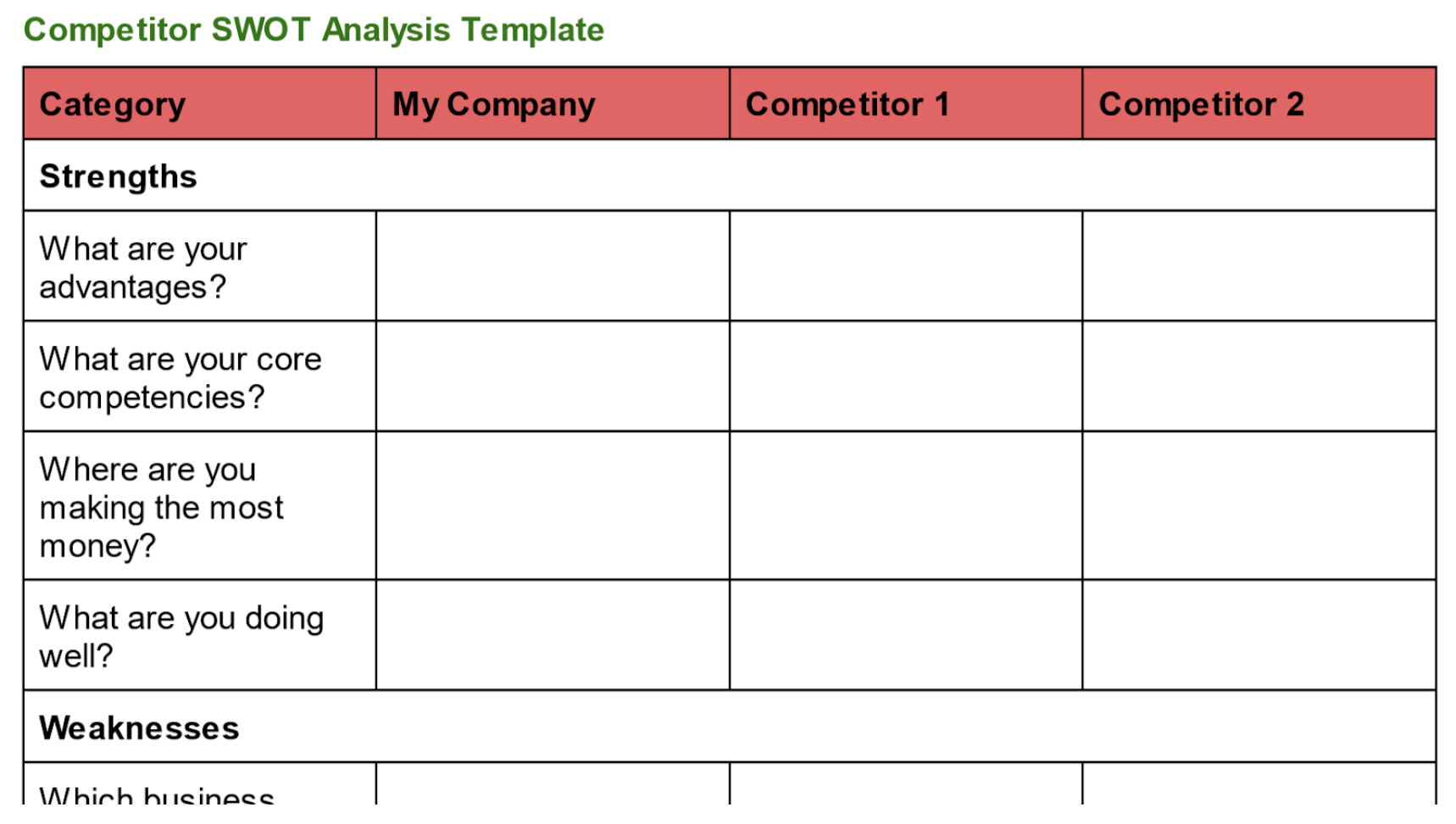
The Competitor SWOT Analysis Template enables you to evaluate and compare your business to competitors. You’ll understand how competitors operate, where they excel, and where vulnerabilities exist. With this information, you can refine your strategies and gain a competitive edge.
It’s ideal for business owners, marketers, and strategists seeking a competitive analysis of the market to craft informed strategies for growth and differentiation.
Download the Competitor SWOT Analysis Template
8) Simple SWOT Analysis Template

The Simple SWOT Analysis Template is an easy-to-use framework that will help your business identify its strengths, weaknesses, opportunities, and threats without going through several pages. It’s organized on a single page, so you can easily organize your insights without losing unnecessary details.
You can use this template whether you are a startup, small business, or large corporation.
Download the Simple SWOT Analysis Template
9) Employee SWOT Analysis Template

An employee SWOT analysis template is useful for employees and managers in an organization. For instance, your team members can use this tool to reflect on their skills, competencies, and potential areas of growth. Company departments or your HR team can use this for performance reviews to help make any changes.
Download the Employee SWOT Analysis Template
10) Marketing SWOT Analysis Template
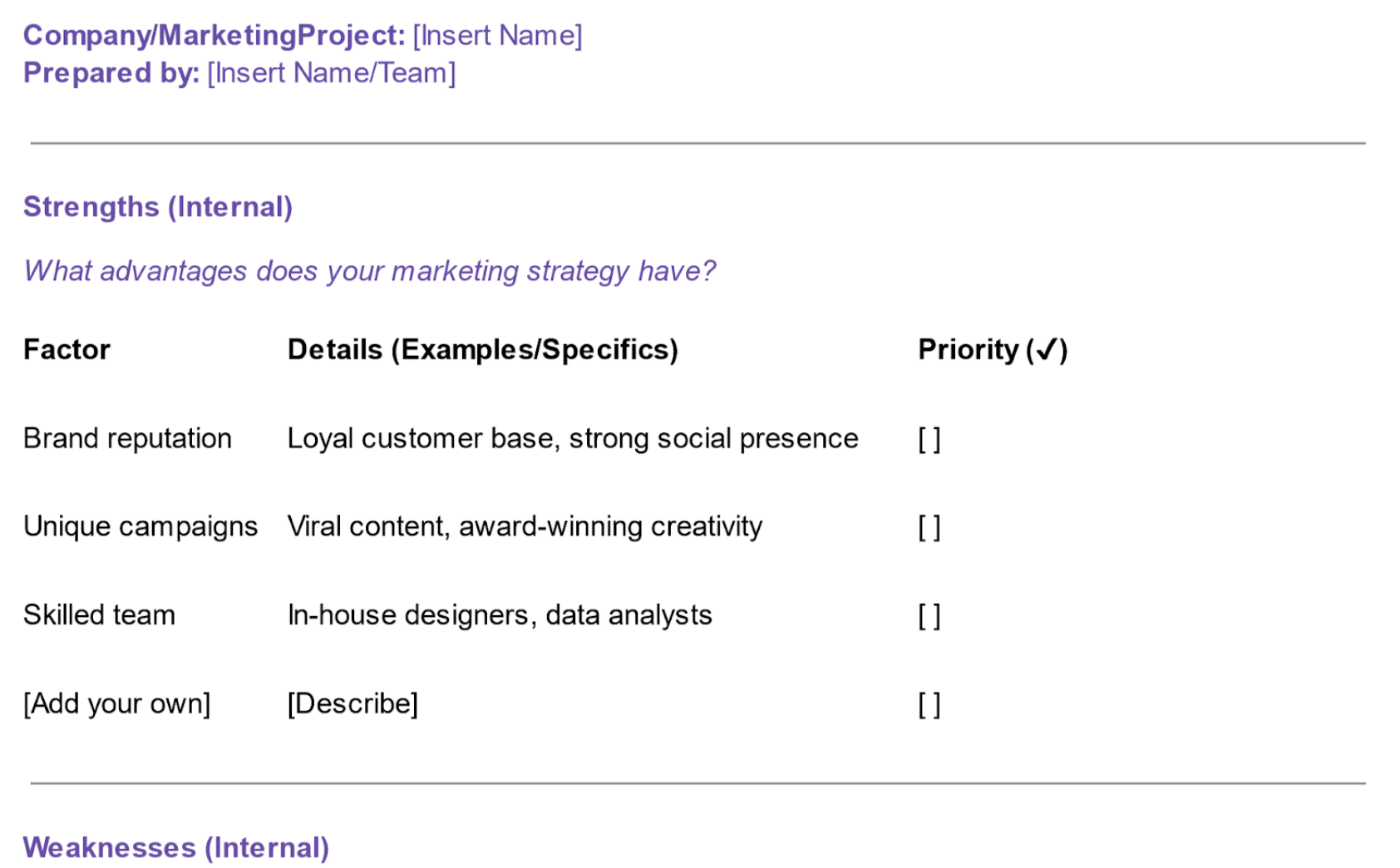
Your marketing team can use this SWOT analysis template to assess marketing strategies and campaigns. Once you analyze this information, the marketing managers and strategists can position the brand much better. You can use this when launching a new product, rebranding, or analyzing marketing performance.
Download the Marketing SWOT Analysis Template
11) Brand SWOT Analysis Template
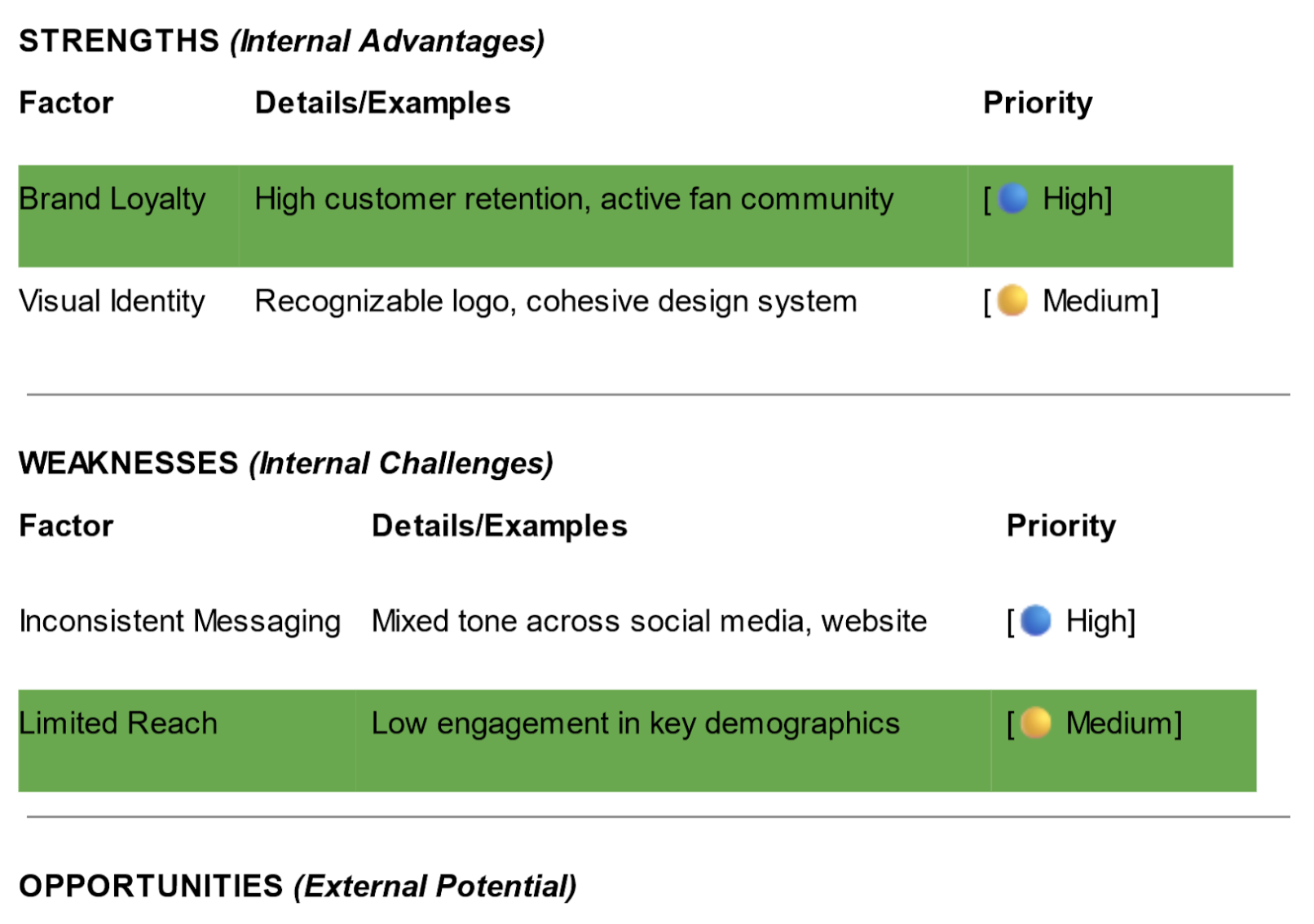
The Brand SWOT Analysis Template evaluates operations to identify key attributes that influence brand perception. It can also help you identify areas for continuous improvement and analyze external factors affecting brand positioning. This template is perfect for brand managers, marketing teams, and business owners who want to strengthen their brand identity and enhance their market presence.
Download the Brand SWOT Analysis Template
12) Hotel SWOT Analysis Template
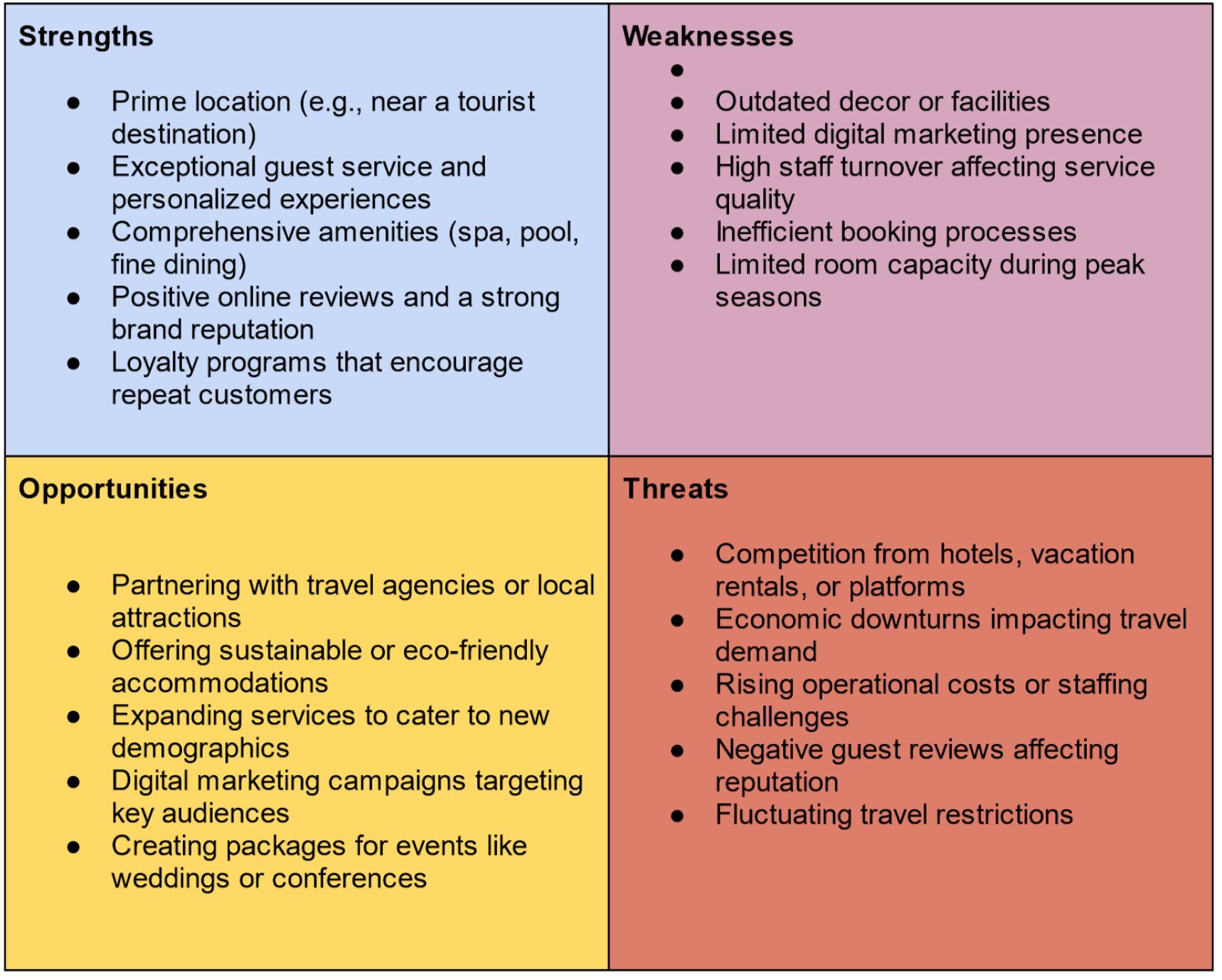
With a hotel SWOT analysis template, you can evaluate your strengths, weaknesses, opportunities, and threats that impact your business. For instance, if the hotel has a good location and ambiance, this can be a good strength to capitalize on.
As the owner or hotel manager, you can use the tool to identify and mitigate any negative issues that will affect your business—both internal and external—to keep your hotel business successful.
Download the Hotel SWOT Analysis Template
13) HR SWOT Analysis Template

The HR SWOT analysis template helps human resources teams evaluate employees in your organization. It provides a structured framework for assessing HR processes in the business, identifying what’s valuable, and identifying areas that can be improved, such as new hire onboarding and training.
In addition, the template can be useful when analyzing the roles of all employees and departments to determine their value.
Download the HR SWOT Analysis Template
14) Sales SWOT Analysis Template
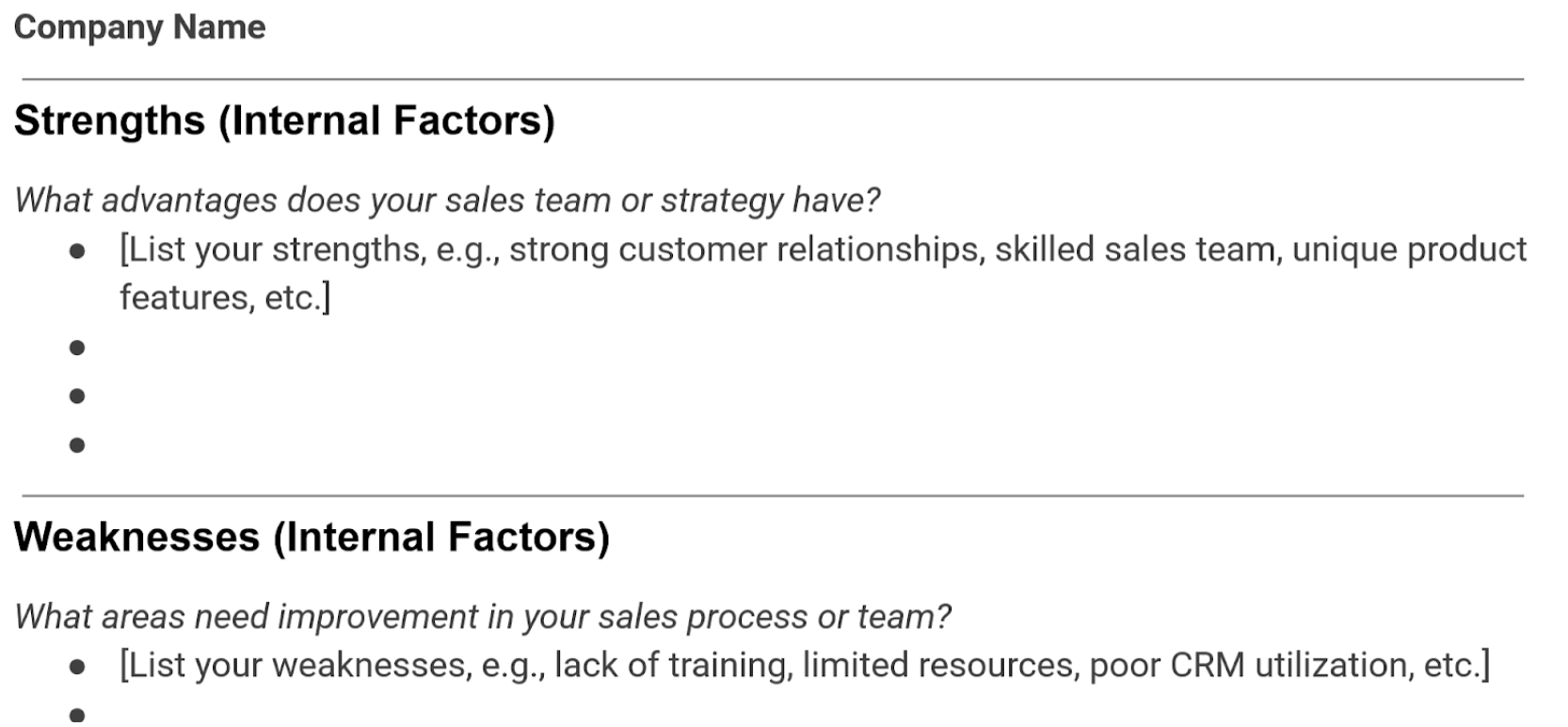
Just like the marketing template, this Sales SWOT Analysis template is a vital tool for evaluating your sales performance and how they compare to your competitors. You can evaluate the sales and marketing team to determine their capabilities in helping you achieve your sales targets.
Additionally, this template is useful in analyzing internal sales processes and external market factors that may affect the company and eat into your market share.
Download the Sales SWOT Analysis Template
15) Team SWOT Analysis Template

Your team has strengths that allow them to be successful at their job. They also have weaknesses, and that can affect their output. With a team SWOT analysis template, you can evaluate the team’s overall strengths, weaknesses, opportunities, and threats. This way, you identify which individuals are struggling and the challenges the team is facing.
You can use this template for project teams, departments, or cross-functional groups to enhance alignment and boost performance.
Download the Team SWOT Analysis Template
16) Professional SWOT Analysis Template
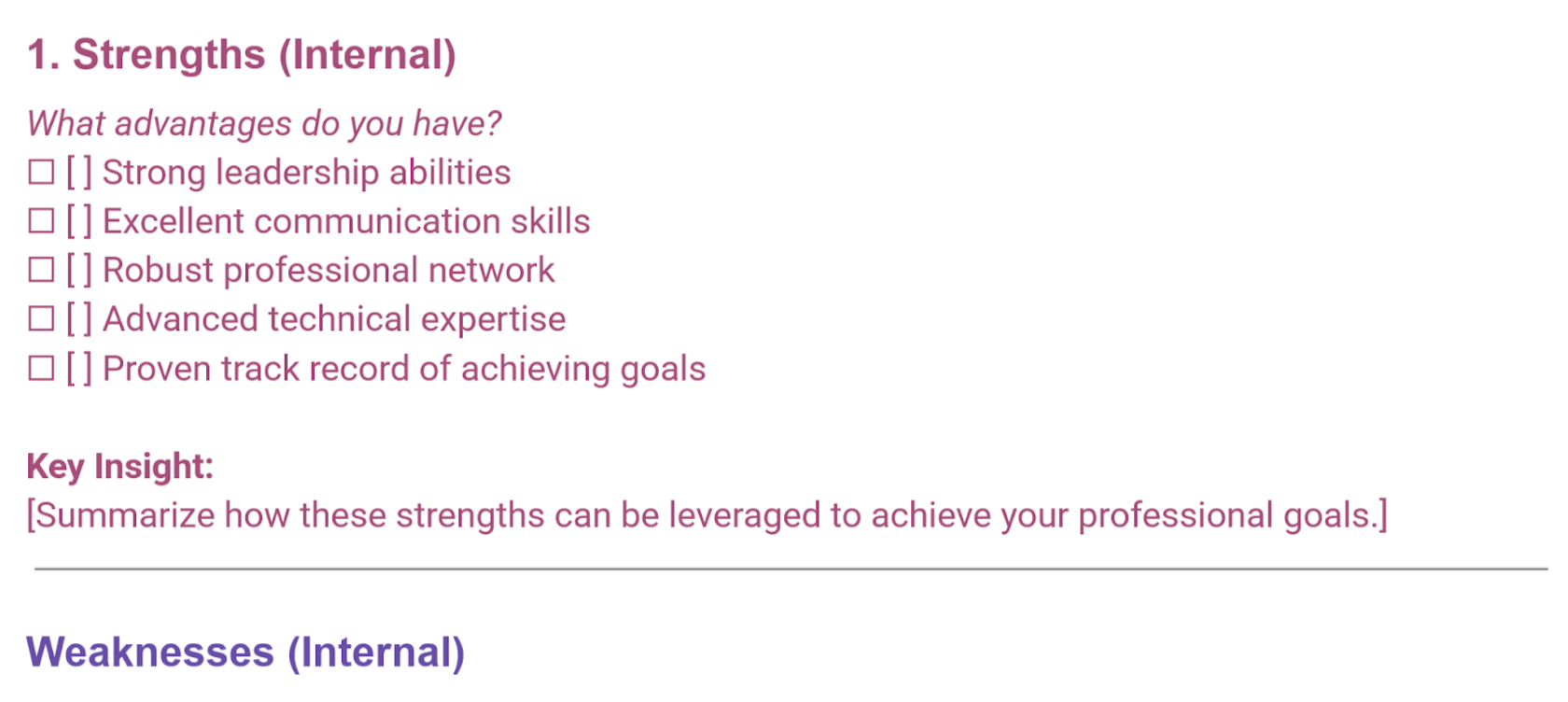
This SWOT analysis template can examine a company’s or individual’s professional capabilities. It can determine the strengths that are ideal for a positive career trajectory and the weak areas that need improvement, uncover growth opportunities, and anticipate potential challenges in the workplace or job market.
As an entrepreneur, you can use this to refine your leadership skills and prepare for upcoming opportunities.
Download the Professional SWOT Analysis Template
17) Business SWOT Analysis Template
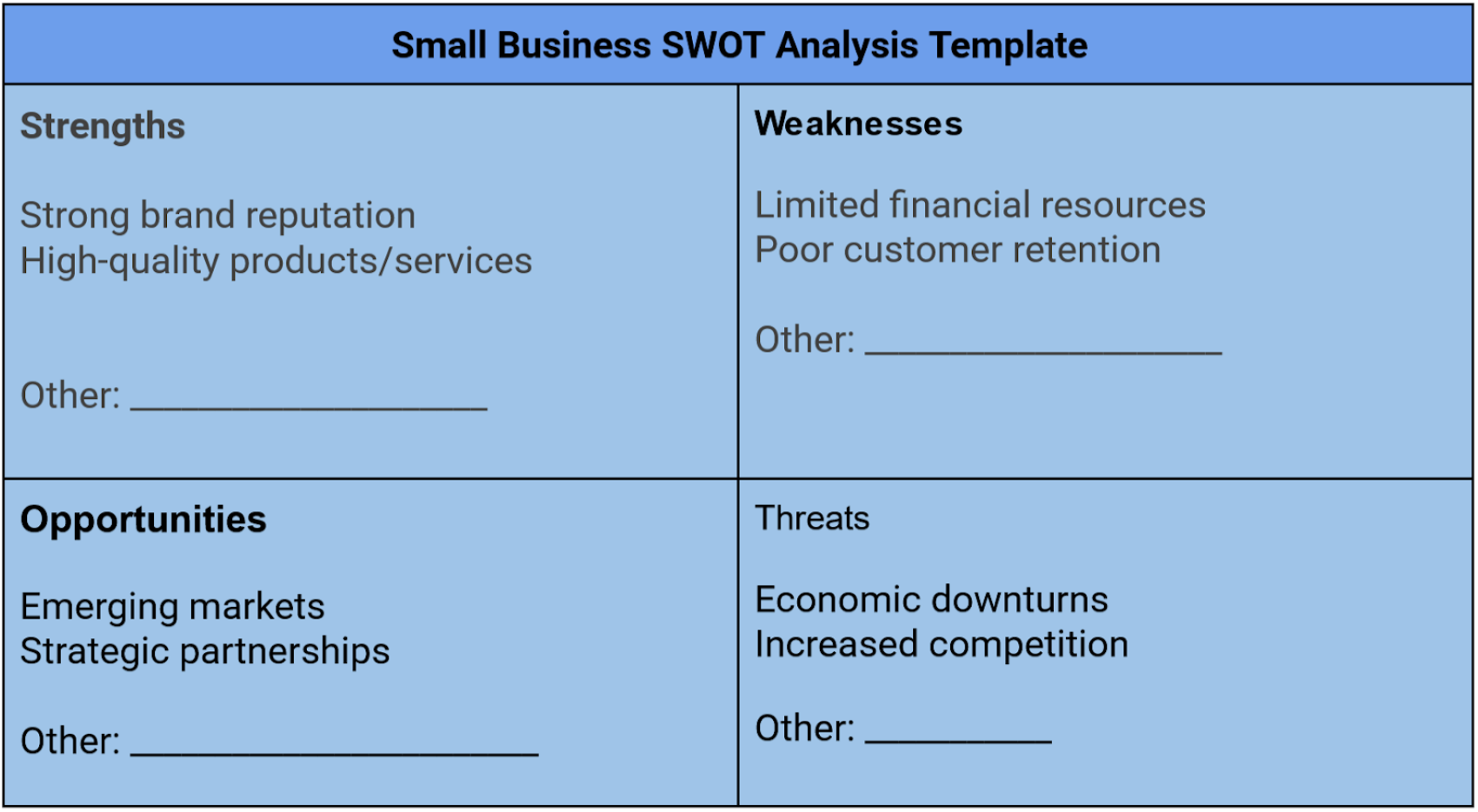
A Business SWOT Analysis Template helps to achieve a more comprehensive SWOT analysis. It assesses the organization’s overall strengths, weaknesses, opportunities, and threats that will impact performance. For instance, if you are a startup, you can rely on this tool to identify market entry strategies, analyze competitors, and determine customer needs.
This analysis is critical for decision-making and strategic planning.
Download the Business SWOT Analysis Template
18) Product SWOT Analysis Template

With the Product SWOT Analysis Template, you can evaluate which customer pain points your product solves. You can build on your product’s strengths and leverage this to market it. Once you identify your weaknesses, you can fix any potential issues. In addition, you can use the opportunities to market the product and mitigate potential external risks that could affect your success.
Download the Product SWOT Analysis Template
19) Restaurant SWOT Analysis Template

For your restaurant business to thrive, you must know the internal and external factors that could affect operations. A restaurant SWOT analysis template will clearly show these factors to help you plan better. You can use this information to improve customer experiences, open more locations, or overcome operational challenges.
Download the Restaurant SWOT Analysis Template
20) Customer Service SWOT Analysis Template

Customer service is a key part of every business. But how will you know if your services are satisfying your customers? Simple, by using a customer service SWOT analysis template. This tool makes it easier to evaluate the resources available to help the customer and your team’s efficiency.
Download the Customer Service SWOT Analysis Template
21) Nonprofit SWOT Analysis Template

Nonprofit organizations can use the nonprofit SWOT analysis template to evaluate operations, funding, and community impact. It’s ideal for executive directors, board members, and fundraisers aiming to strengthen their mission and overcome challenges.
Download the Nonprofit SWOT Analysis Template
How to Enhance Your Company’s SWOT Analysis Using SweetProcess

Creating and managing a SWOT analysis for your business can feel overwhelming, especially when juggling multiple team members and tasks.
SweetProcess simplifies this by providing a centralized platform to document, manage, and update your SWOT analysis effectively.
With SweetProcess, you can streamline the entire process, collaborate seamlessly with your team, and ensure that your SWOT analysis stays up-to-date and actionable.
You can also access free SOP templates for easier documentation.
Here’s how SweetProcess helps you enhance your company’s SWOT analysis:
Create a Business Process
A business process organizes your strengths, weaknesses, opportunities, and threats, ensuring that every element is systematically recorded and accessible. Here’s how to use SweetProcess for this task:
- Open the “Processes” tab and select “Create Process.”

- Name your company process.
- Assign this process to the right team members to manage it.

- Include notes, visuals, and additional details to provide an overview of the process.

- Save these changes and tap “Finished Editing.”
Add a Procedure to a Business Process
Within your SWOT analysis process, you can add specific procedures to break down the analysis into actionable steps. For instance, you can create procedures for gathering data, brainstorming with your team, or analyzing key findings, making it easier for everyone to contribute and follow along.
Follow these steps:
- Choose a specific process you’ve previously created or add a new one.
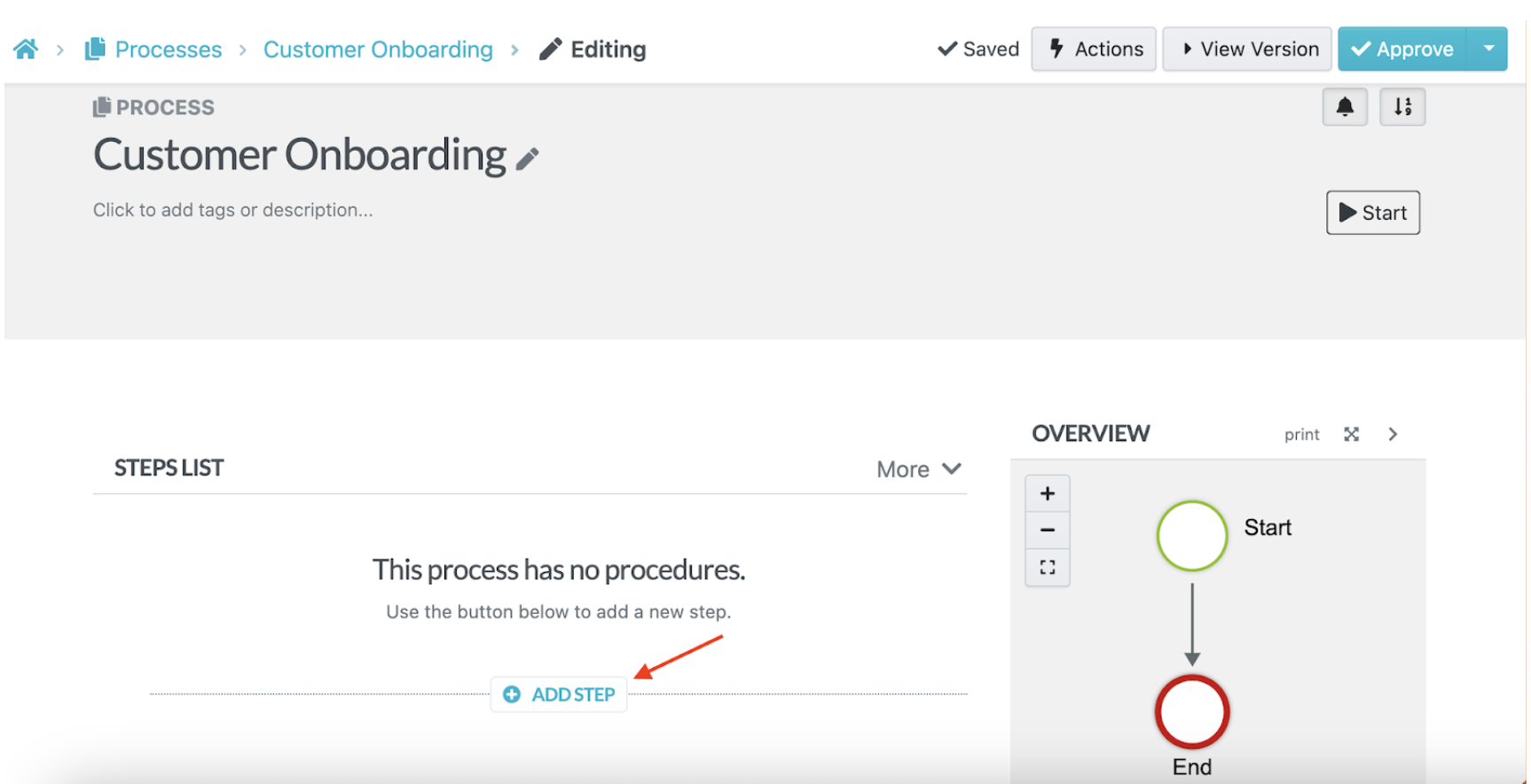
- Scroll down to the bottom to add more steps.
- You can arrange your procedures in a logical order to make it easy for team members to follow.

- Once you have added all the steps, save your changes and share them with the managers or other stakeholders for approval.

View the Version History of a Process
One of SweetProcess’s standout features is its version history. You can track changes to your SWOT analysis over time, ensuring that you maintain a clear record of updates and process improvements. This is especially useful when reviewing past decisions or identifying patterns.
- Open the specific process you need from the dashboard.
- On the left-hand menu, select the “Version History” icon. It’s marked with a clock icon.
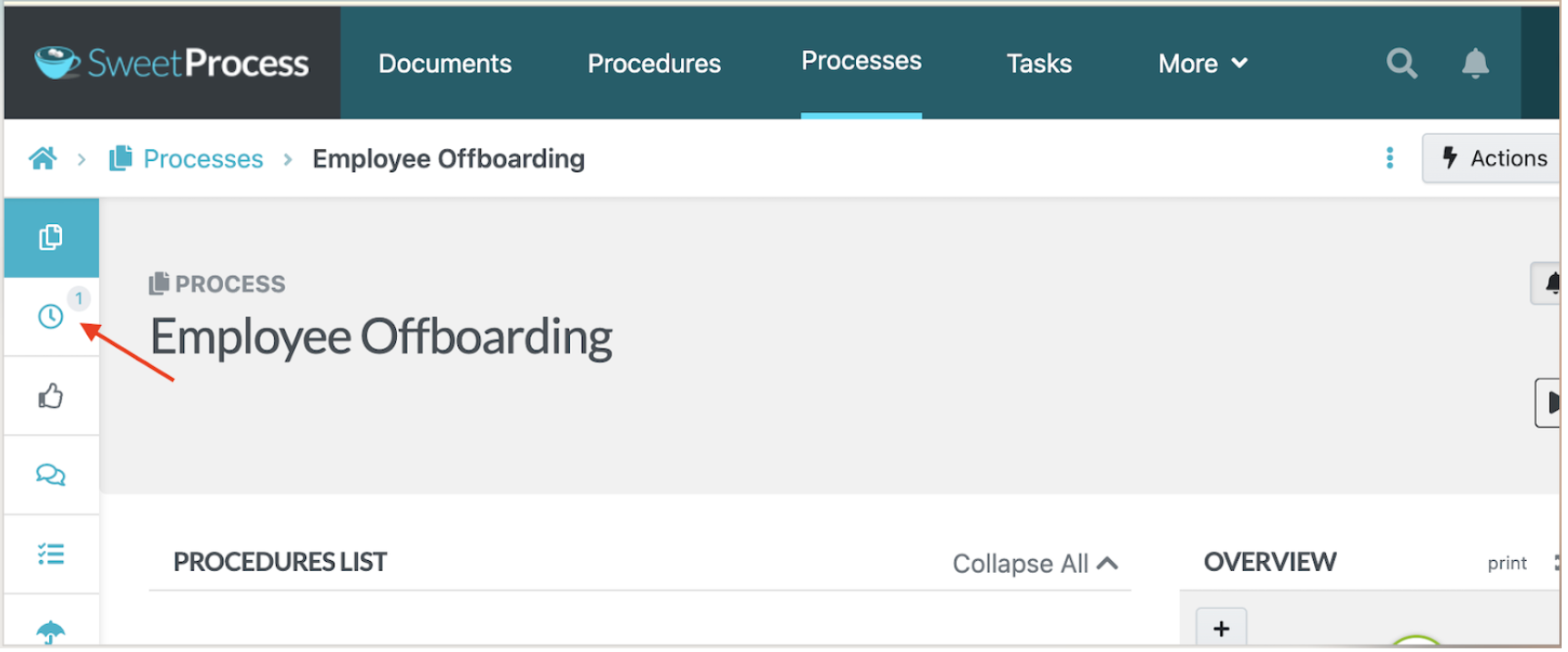
You can review previous versions of your SWOT analysis to track recent edits and updates. In addition, you can restore the older version.
Assign Tasks and Collaborate With Team Members
SweetProcess makes team collaboration effortless. You can assign specific tasks, such as analyzing opportunities or listing weaknesses, to team members and monitor progress in real time. This ensures accountability and promotes teamwork.
Follow these steps:
- Select the “Tasks” button on the main menu.
- Tap “Assign Tasks.”

- You have the option to assign specific tasks from existing processes or procedures.
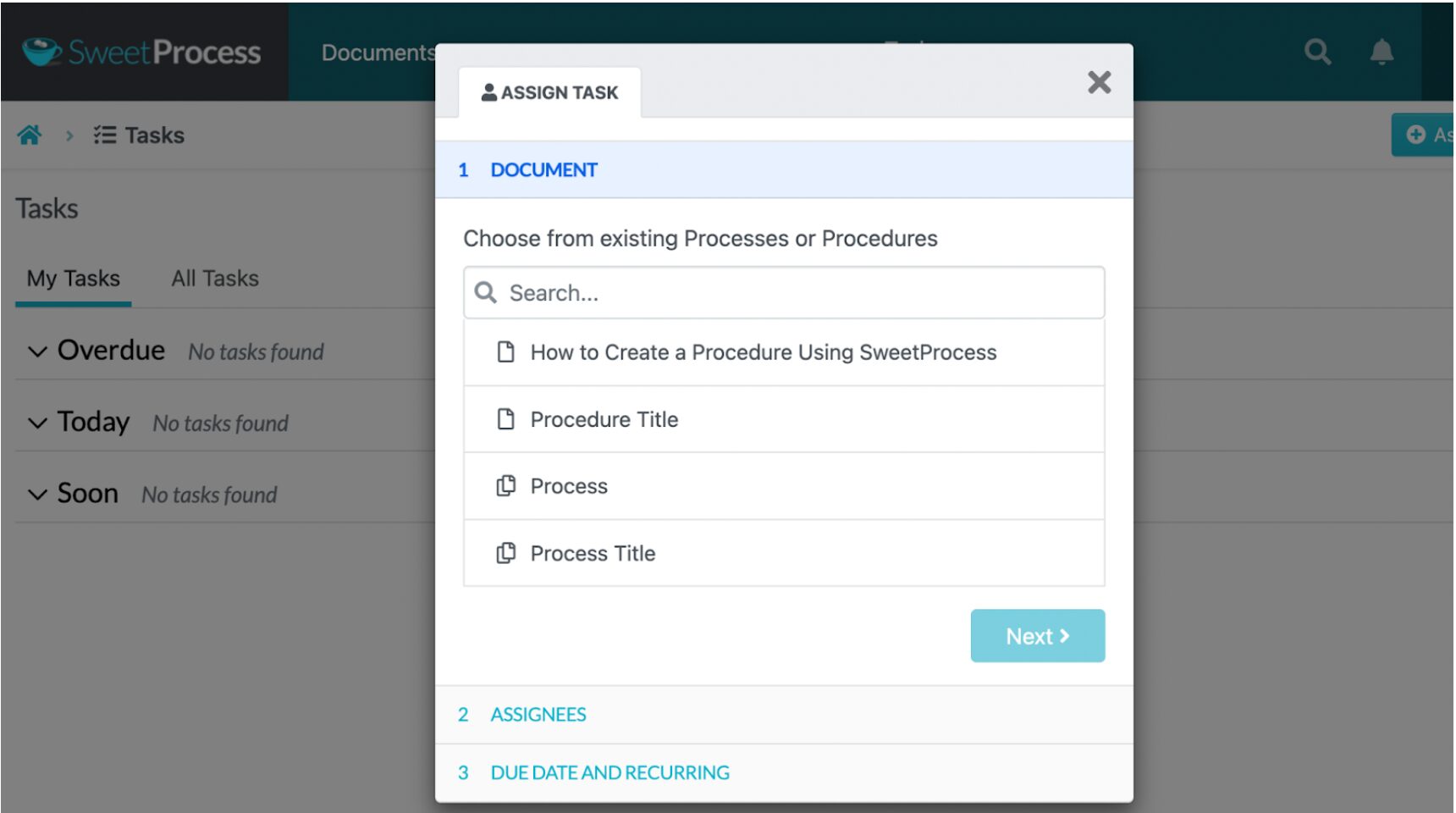
- Scroll down to the “Assignees” section to select the specific team members.
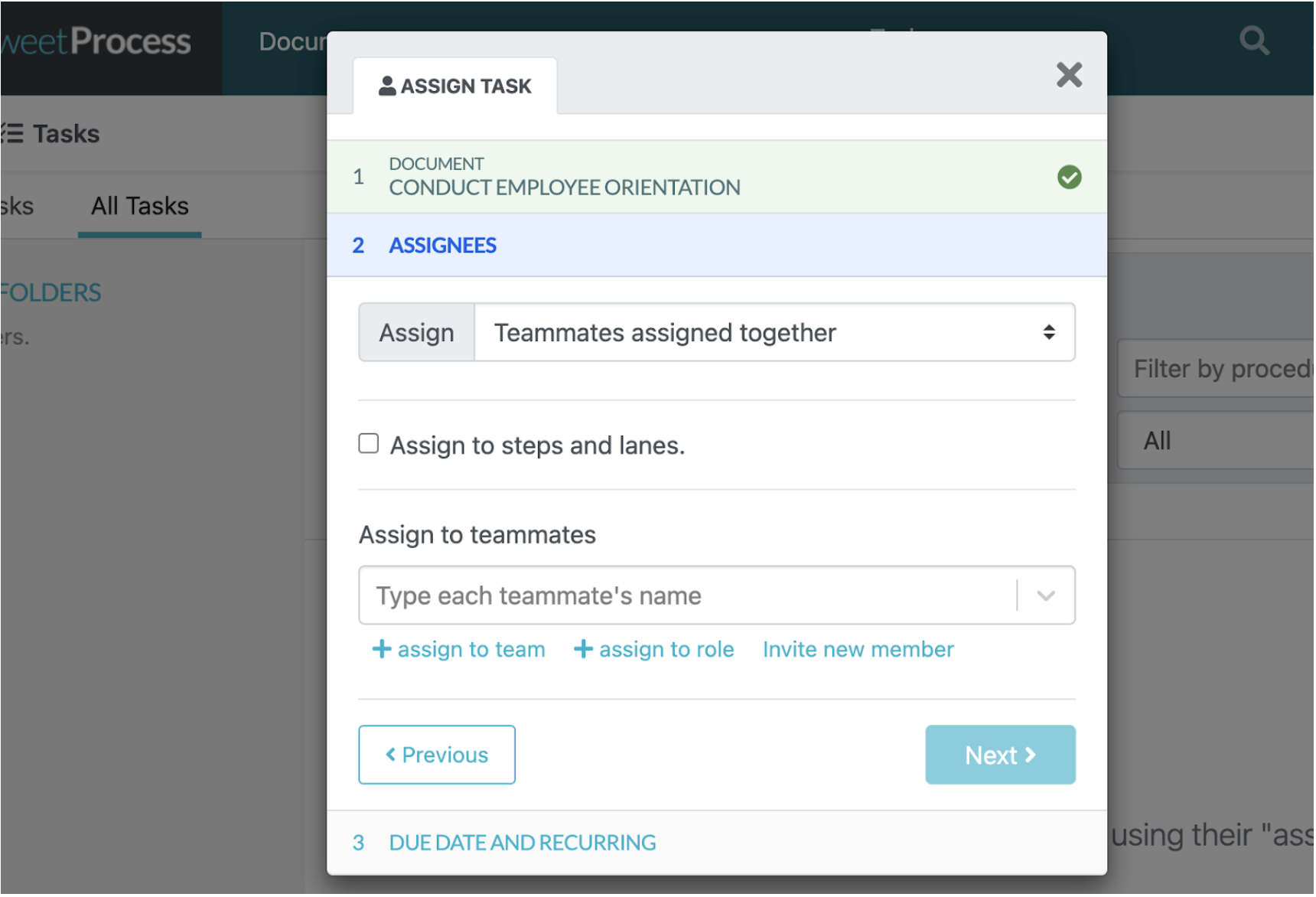
- Include a due date for better tracking.
- You can also indicate if the task is recurring.
Thanks to these SweetProcess features, several small business owners have implemented the software in their processes.
One of them is IT company XL.net. The company focused on creating tailored strategies for managing clients’ technology needs. However, the company struggled with inefficiency caused by an overwhelming number of over 2,500 business processes. The CEO, Adam Radulovic, realized that they were inefficient because of this.
Additionally, employees found it challenging to identify relevant processes, wasting time and effort. Their inability to streamline workflows impacted productivity and client satisfaction. XL.net was introduced to SweetProcess through one of their clients, who had used it successfully. Impressed by its simplicity and effectiveness for small-to-medium businesses, they decided to try it.
After testing the platform, they started enjoying these benefits:
- Streamlined Documentation: They migrated and organized thousands of outdated, redundant processes into a centralized, easy-to-manage system.
- Quality Assurance Maintenance: They achieved consistent, predictable results and improved efficiency by actively managing their processes.
- Employee Learning and Empowerment: Centralized documentation closed the knowledge gap among employees, enabling them to access accurate information and avoid mistakes.
- Simplified Operations: SweetProcess’s user-friendly interface made it easy for employees to adopt and use the system.
Another beneficiary of SweetProcess is MonteVista Homes, a second-generation family-owned home building company. Despite their commitment to excellence, the company struggled with inefficiencies due to poor process documentation. Loose-leaf SOPs and desk manuals were outdated, hard to update, and largely unused.
This lack of organization caused operational challenges, especially in managing the complexities of home construction involving multiple trade partners and projects. Seeking a better solution, President Luke Pickerill explored software options online and found SweetProcess. Luke was reassured by SweetProcess’s robust features, such as data safety and the ability to download documents at any time.
With this tool, the company has achieved:
- Easy and Effective Documentation: The organization created and updated SOPs seamlessly, eliminating outdated and ineffective desk manuals.
- Streamlined Employee Onboarding: SweetProcess reduced onboarding time from weeks to a few hours by providing accessible training libraries with grouped procedures and videos.
- Accessible Reference Point: Employees in the sales and construction departments gained instant access to standardized procedures, reducing the need for one-on-one training.
- Improved Workflow: By documenting key tasks and identifying bottlenecks, the team optimized their operations without overcomplicating processes.
Benefits of Conducting SWOT Analysis for Your Business

SWOT analysis is a proven tool for business success. In fact, research by the Competitive Intelligence Alliance shows that over 50% rated their latest SWOT analysis as effective, scoring it 3 out of 5. This demonstrates how effective SWOT analysis can drive better decisions and outcomes.
Here’s how it can benefit your business:
Get a Bird’s Eye View
How well do you understand your business? A SWOT analysis offers a high-level overview of your company’s strengths, weaknesses, opportunities, and threats. For instance, if your sales are booming but customer retention is low, a SWOT analysis can uncover patterns that link these trends, enabling you to address them.
You don’t have to be overwhelmed with all the internal and external problems; you can prioritize and address key issues.
Improve Specific Campaigns and Projects
Imagine running a marketing campaign that underperforms. A SWOT analysis helps identify the reasons. Perhaps your target audience wasn’t clearly defined, or you overlooked market opportunities that could have strengthened the campaign. With these insights, you can refine your approach and turn a struggling campaign into a success story.
Develop Tangible Road Maps
Where does your business want to be in the next 12 months? Do you want to expand from an exclusively physical store to offering e-commerce services? A SWOT analysis can help you identify potential threats, such as increased competition, and prepare before the launch.
With these insights, you can have an effective strategy to overcome potential roadblocks and stay ahead of your competitors.
Risk Management
Think of all the changes that could happen in the market, from economic downturns to new industry regulations and supply chain disruptions. These risks could derail your business goals if you are unaware or ill-prepared. However, you can anticipate these risks with a SWOT analysis and develop plans to buffer your business.
For instance, if you foresee a supply chain disruption, you could diversify suppliers or increase your inventory to protect your business.
Resource Allocation
Are you spending too much on areas that don’t deliver results? A SWOT analysis reveals where to focus time, money, and effort. For instance, if you run a manufacturing company whose strength is in innovation, directing more resources toward R&D could maintain a competitive edge.
This way, you can avoid unnecessary wastage of resources.
Identifying Competitive Advantage

Competition is rampant in most industries. Therefore, you need to know your unique selling point to secure your market share. You can capitalize on your strengths, such as superior customer service or exclusive product features, to leverage your competitive edge more confidently.
Strategic Planning
A SWOT analysis will come in handy in your strategic planning sessions. Let’s say you operate a fitness studio. You can identify if there’s a growing demand for virtual classes and use these insights to invest in online platforms that allow you to offer this service. At the same time, you might be solving a weakness, such as limited class capacity and expanding your schedule.
This tool helps with the business process analysis so that you can set clear goals and prioritize business initiatives.
Enhancing Communication
Does your team struggle with alignment? With more employees working remotely or in a hybrid environment, you need to have a shared understanding of your business goals. SWOT analysis will boost discussions from all teams and departments to ensure everyone is on the same page.
Adaptation to Change
Your organization must adapt fast or risk falling behind. For instance, consumers are focusing more on online shopping. Therefore, if your business wants to reach more customers, you need to know such trends and respond to sudden shifts. Once you conduct a SWOT analysis, you can adjust to changes and adapt quickly and effectively.
Best Practices for Using SWOT Analysis in Your Business
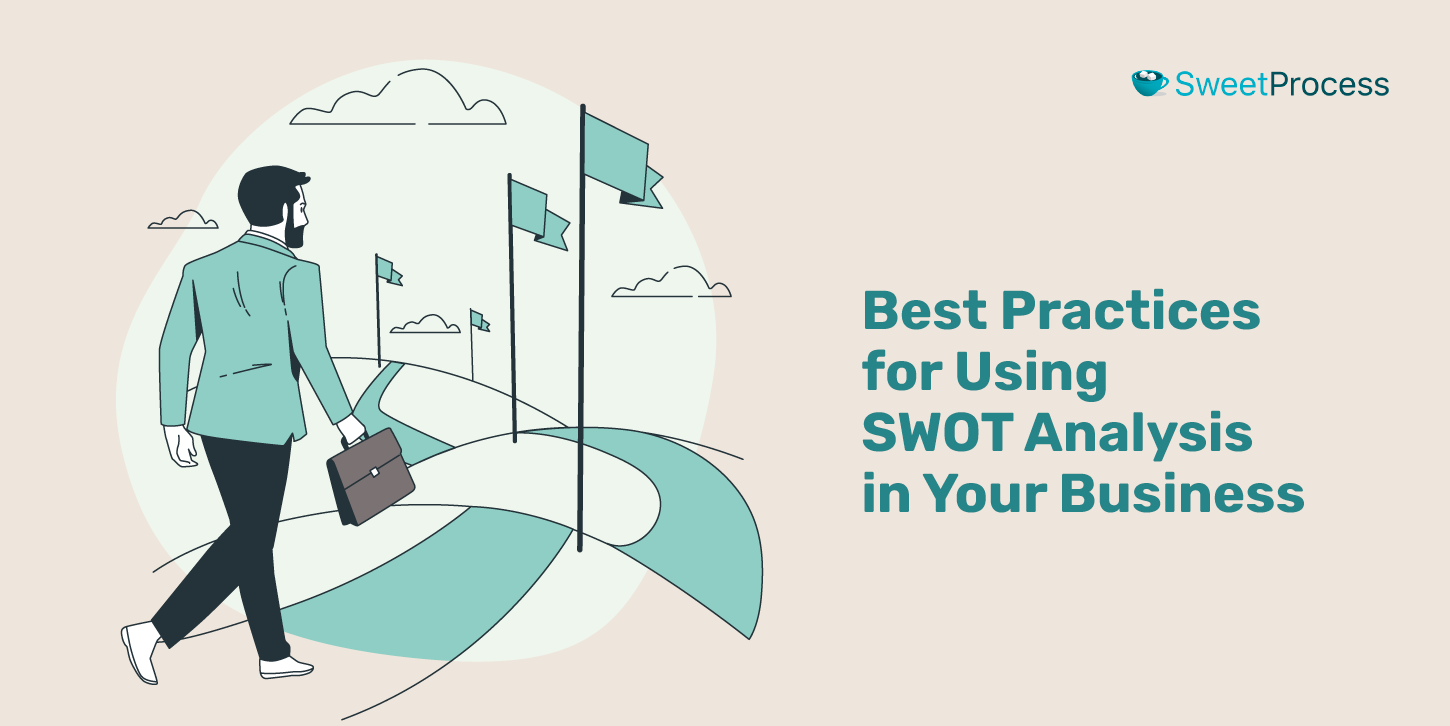
While conducting a SWOT analysis is valuable, following best practices ensures you get the most out of it. Here are some practical tips to maximize the impact of your SWOT analysis and ensure it benefits your business:
Incorporate Data
Instead of relying on subjective assumptions and gut feelings, incorporate data into your SWOT analysis. For example, if you’re assessing weaknesses, use customer feedback or sales reports to back your findings. Data-driven insights clarify and eliminate guesswork, making your SWOT analysis more actionable.
Prioritize Factors
As you conduct your SWOT analysis, remember that not all strengths, weaknesses, opportunities, and threats are equally important. Identify and focus on the factors that have the greatest impact on your business. For instance, if a major opportunity involves entering a growing market, prioritize it over smaller, less impactful opportunities.
Prioritization ensures you allocate resources effectively and tackle the most critical issues first.
Complement With Other Tools
While SWOT analysis provides valuable insights, it works best when combined with other tools. For example, a political, economic, sociological, technological, legal, and environmental (PESTLE) analysis can help evaluate external factors that influence your business. This framework allows you to assess key trends such as economic shifts, regulatory changes, or technological advancements that might impact your industry.
For instance, if new regulations emerge in your sector, a PESTLE analysis can help you anticipate compliance challenges and adjust your strategy accordingly. Similarly, if technological advancements are reshaping customer preferences, you can leverage this insight to stay ahead of competitors.
By using SWOT and PESTLE together, you create a comprehensive approach to business strategy, ensuring that both internal capabilities and external factors are considered.
Regular Updates
Does your SWOT analysis reflect your current reality? Markets change, competitors evolve, and customers need to shift. Schedule regular reviews of your SWOT analysis, either quarterly or biannually, to keep it relevant and aligned with your business goals. For example, if a new competitor enters your market, update the “threats” section immediately to stay ahead.
Conducting a SWOT analysis is just the first step, but implementing it effectively is where the real magic happens.
Streamline Your SWOT Analysis Process Using SweetProcess
A well-executed SWOT analysis can be the difference between your organization staying stagnant and unlocking your business’s full potential. This tool helps you identify your strongest opportunities and biggest risks, as well as address your weaknesses. However, the true power of SWOT analysis lies in how well you manage and apply the insights you collect.
To truly maximize these benefits, you need the right tools to keep your analysis organized, accessible, and actionable. SweetProcess is your ultimate partner in achieving this. Its intuitive platform simplifies every step of the SWOT analysis process, from documentation to team collaboration, ensuring your strategies are always on point.
